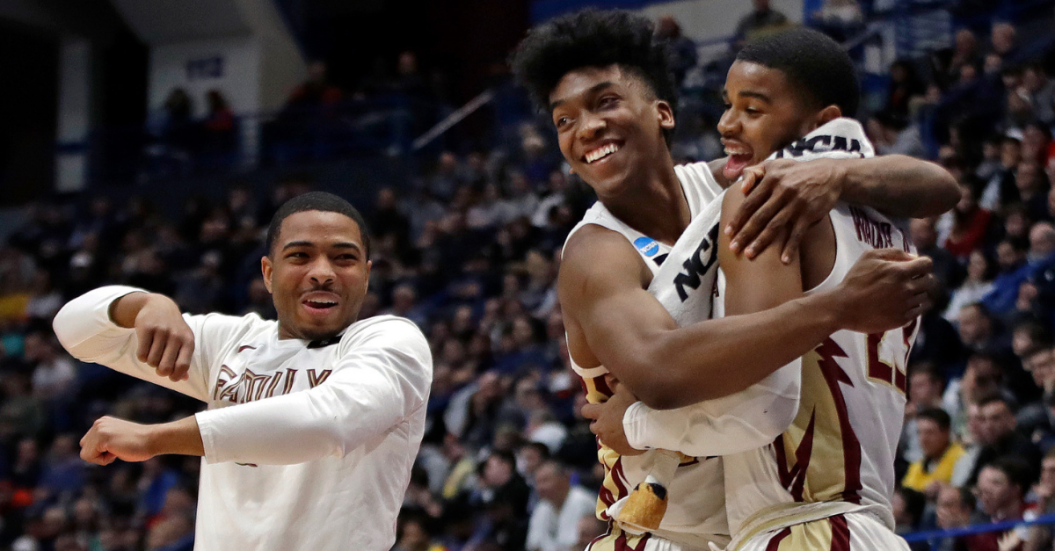After struggling in the opening round of the NCAA Tournament, beating Vermont by just seven points, the Florida State Seminoles showed why they should be feared by beating Murray State, 90-62, to advance to the Sweet 16.
The fourth-seeded Seminoles did everything well to beat the 12th-seeded Racers on Saturday, though Ja Morant was still able to score at a high rate. However, there are many reasons why the 'Noles controlled the game from start to finish, and many of those are what hurt them against Vermont.
RELATED: If Phil Cofer's Final FSU Season Wasn't Tough Enough, His Dad Passed Away
After the first-round game, I wrote about the five biggest takeaways in the opening round. I think all five were definitely better this time around. Some of those issues were big reasons they were so successful against Murray State, but what are all of the reasons the Seminoles advanced?
1. FSU Controlled the Glass
After the game against the Catamounts, one of the stats that stood out and worried me was the battle on the glass. In that game, the Seminoles had 39 rebounds to 33 for Vermont, which isn't exactly great since they only had one player taller than 6-foot-6. But they made sure to change that narrative this time, finishing with 45 rebounds compared to 33 for the Racers.
Florida State had 15 offensive rebounds and 20 second-chance points in the game. Christ Koumadje led the team with nine rebounds, Terance Mann had eight, Mfiondu Kabengele added seven, and MJ Walker finished with six. In the first few minutes of the game, it was obvious Murray State had no answer for Koumadje and his height. And even once he was on the bench, Kabengele took over and dominated as well.
Moving forward with opponents like Gonzaga, there won't be such a big size advantage, but it is important to take advantage of the opportunities when they are there.
2. 'Noles Took Away Ja Morant's Teammates
Florida State wanted to cover everyone straight up and not allow anyone to beat them except for Morant. In the first round, Morant had 16 assists, and the game plan for the Seminoles was to not allow that by taking away any open looks for his teammates.
That wound up being successful with Morant finishing the game with just four assists, his second-lowest total on the season. If they could keep Morant from making his team better and turn him into a score-first player, they must have felt they could win the game easiest. Morant hit five 3-pointers in the first half, and, other than that, really wasn't overly efficient with making just 3 of 15 two-point shots.
The rest of the team finished the game 12-for-40 from the field, just 30 percent, and 2-for-12 from three, just 16.7 percent. As a team, they shot 32.8 percent from the field and struggled to score outside of Morant's 28 points.
3. Leonard Hamilton's Bench Dominated
Always take the bench stats with a grain of salt since Kabengele comes off the bench, but it was still crazy how much the reserves dominated this game. The final output from the bench was 47-6 in favor of the 'Noles, with Kabengele accounting for 22 points and PJ Savor and Anthony Polite each scoring nine.
The bench also controlled the glass, pulling in 17 rebounds compared to just seven by the Murray State bench. One of Leonard Hamilton's strategies has always been to play a lot of players that can help the team. He has really committed to that this season. On the season, there are 11 players who average at least 10 minutes. The top scorer on the team, Kabengele, only plays 21 minutes per game. Most teams would be asking him to play at least 30 minutes, if not more. For example, Morant played 38 minutes in this game, and maybe would have played all 40 if it had been closer down the stretch. On the season, he averaged over 36 minutes per game.
4. The Seminoles Shared the Ball
Against Vermont, Florida State finished the game with just six assists. Against Murray State they had 21 on 36 made field goals. Assisting on 58.3 percent of made shots is pretty solid, and better than the season percentage. One of my favorite stats to look at for a team is how much they are assisting each other in scoring. It is why watching a team like the Houston Rockets makes me cringe. Ball movement and sharing the ball gets better looks for each player and allows for anyone to score. Kabengele and Mann could probably each score 20 points per game if they each played played more minutes and had the ball dumped down into the paint on most possessions. It makes for sexy stat lines, but it hurts the team when they rely on one player for scoring, which is why the Racers struggled when Morant couldn't set everyone else up.
5. Florida State's 3-Point Defense
The biggest reason for just a seven-point win in the first round was the Catamounts' ability to hit 16 shots from behind the arc. Now, not all of the shots were wide open, but the Seminoles still allowed too much space and it killed them and almost ended their season. Yes, Morant hit five first-half threes, but they were trying to take away the drives and ability to share the ball, so he had some open looks from deep and made them. It was worth the risk of him making tough threes if it meant no one else was getting open shots on kick-outs.
Florida State were played straight up on everyone, and didn't double Morant. In the first round, Morant was sucking the defense into the paint and finding his teammates outside for wide-open shots.
